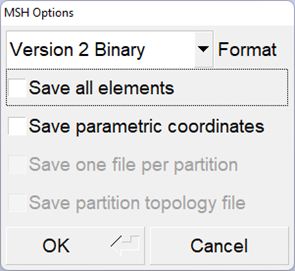gmsh2nek¶
Nek5000 provides a conversion tool to convert Gmsh <https://gmsh.info> meshes (.msh files) into Nek meshes (.re2 files) called gmsh2nek.
The source code is located in nek5000/tools, and it can be compiled from that directory with ./maketools gmsh2nek.
In addition to the compilers necessary to use Nek5000, gmsh2nek requires cmake.
See Before You Begin for more information on dependencies.
Once it is compiled, the executable will be available in nek5000/bin.
Before converting a Gmsh mesh, make sure to save it with the appropriate format. Both ASCII and binary version 2 formats are supported. The Binary format is recommend for large meshes. The appropriate options from Gmsh are shown in Fig. 10.

Fig. 10 Recommended options when saving a Gmsh mesh for compatibility with Nek5000
Note
Leave both boxes unchecked when exporting the mesh from Gmsh.
The procedure for running gmsh2nek is simpler compared to exo2nek.
The expected input steps are as follows:
- It will first ask you for the dimension of the mesh (either 2 or 3).
- Next, it will ask for the input Gmsh file.
The
.mshextension is implied and should not be included. - The tool will then begin converting the mesh and will print a summary of the boundary IDs.
- Finally, it will ask for the number of periodic boundary pairs (see Periodic Boundaries below). If your mesh has none, simply enter 0.
gmsh2nekwill then output a new.re2file with the same file name as the input Gmsh file.
An example is shown below with the expected user input highlighted.
Enter mesh dimension: 3
Input .msh file name: pipe
total node number is 8569
total quad element number is 416
total hex element number is 960
******************************************************
Boundary info summary
BoundaryName BoundaryID
Inlet 1
Outlet 2
Wall 3
******************************************************
Enter number of periodic boundary surface pairs:
0
writing pipe.re2
When using a converted Gmsh mesh, the user must set up boundary condition in the .usr file in either the usrdat or usrdat2 subroutines, e.g.
do iel=1,nelv
do ifc=1,2*ndim
id_face = BoundaryID(ifc,iel)
if (id_face.eq.1) then ! surface 1 for inlet
cbc(ifc,iel,1) = 'v '
elseif (id_face.eq.2) then ! surface 2 for outlet
cbc(ifc,iel,1) = 'O '
elseif (id_face.eq.3) then ! surface 3 for wall
cbc(ifc,iel,1) = 'W '
endif
enddo
enddo
or
call setbc(1,1,'v ') ! set bcID 1 to inlet for field 1 (velocity)
call setbc(2,1,'O ') ! set bcID 2 to outlet for field 1 (velocity)
call setbc(3,1,'W ') ! set bcID 3 to wall for field 1 (velocity)
Periodic Boundaries¶
Periodic boundaries in Nek5000 are implemented on a mesh connectivity level.
They must have a conformal element face distribution with a consistent offset vector.
Only translational periodicity is supported in gmsh2nek.
| Example: | The example below describes the expected inputs for a mesh with a single pair of periodic boundaries. |
|---|
First, the user must provide the number of periodic surface pairs. In this case, we have 1.
Enter number of periodic boundary surface pairs
1
Next the user specifies which surface IDs are periodic. Here, we set the inlet (sideset 1) to be periodic with the outlet (sideset 2).
input surface 1 and surface 2 sideSet ID
1 2
The sideset 1 element faces will be mapped to sideset 2 element faces accordingly.
However, this requires that you have conformal meshes on sidesets 1 and 2.
The P boundary tag will be assigned to the cbc array, while the sideset ID number is still avaialble in the BoundaryID array.
Note
Mulitple pairs of periodic boundaries are supported
Conjugate Heat Transfer Meshes¶
Coming soon!